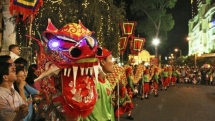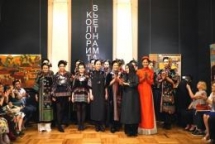"From tradition to tradition": Hang Trong folk paintings revival project
| Vietnamese traditional Tet recreated in heart of Hanoi’s Old Quarter | |
| Vietnamese traditional ‘ao dai’ introduced in Russia | |
| PM asks Norway open market for Vietnamese traditional products |
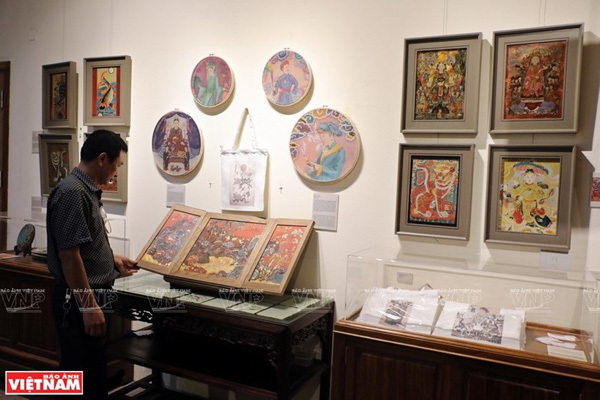 |
| Visitors to the exhibition which is a part of the project 'From tradition to tradition' conducted by the Vietnam University of Fine Arts. (Photo: VNP/VNA) |
With a hope to preserve and promote this line of painting, fine art students are working to recreate the paintings on silk and lacquer, Vietnamnet reported.
Hand-painted or wood-engraved paintings are on display at a wet market stall next to meat and vegetables are barely seen anywhere in the world. In Vietnam, though, it’s a common sight.
People put these pictures on the family altar as well as hang them on the walls. At certain times of the year- particularly Tet, the Lunar New Year – they are considered an indispensable element of the occasion.
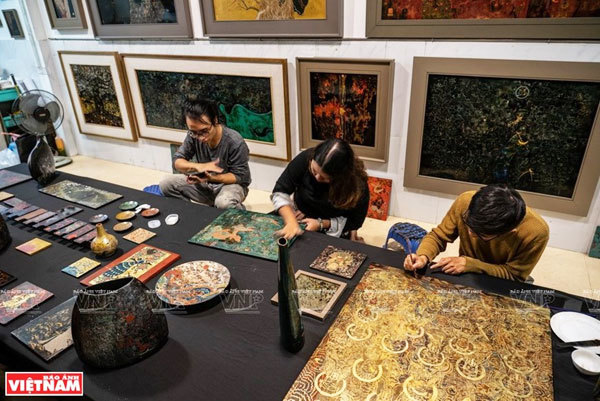 |
| Members of the project 'From tradition to tradition' recreate Hang Trong paintings on lacquer and silk. (Photo: VNP/VNA) |
Inspired by the Hang Trong folk paintings that appeared and now slowly fading away right on this Hang Trong street that used to be old Tho Xuong district, the project “From tradition to tradition” is an effort to create dialogue and to continue writing on values of this traditional painting by using other Vietnamese traditional Painting medium, that is lacquer and silk.
The project is an opportunity for a group of students selected from the lacquer and silk major of the Painting Department, University of Fine Arts of Vietnam to interact , to study the technique , to absorb the love and passion for local culture from the last artist of the Hang Trong painting – artist Le Dinh Nghien.
Within one month, the students participating in the project had the opportunity to study directly from their practical experiences with artist Le Dinh Nghien and to propose creative options for the works inspired by Hang Trong paintings as well as being able to interact directly with the space of Nam Huong Communal House located on Hang Trong Street.
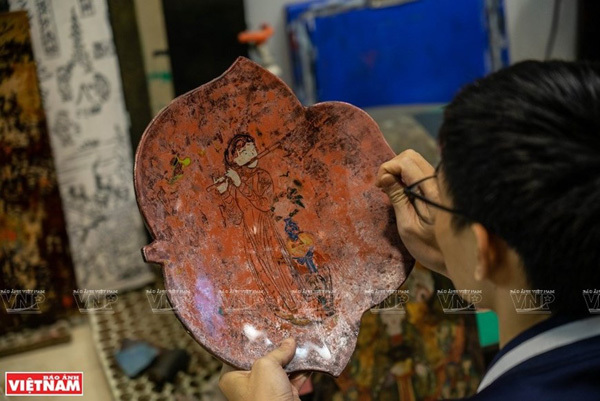 |
| Hang Trong painting has been rated by researchers as highly aesthetical and sophisticated thanks to its woodblock printing and colouring techniques. The paintings also feature deep imprints of the culture and era when they came into being. (Photo: VNP/VNA) |
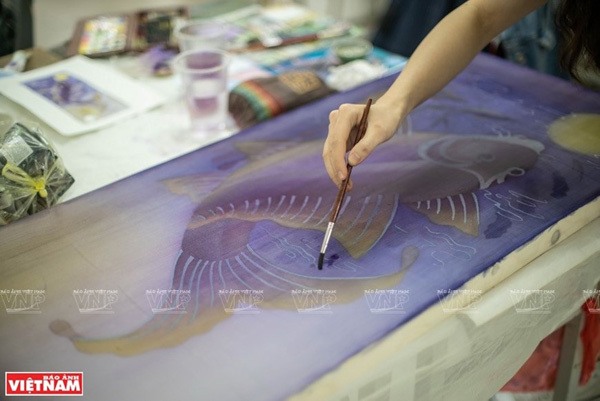 |
| The content of the painting is drawn on silk (Photo: VNP/VNA) |
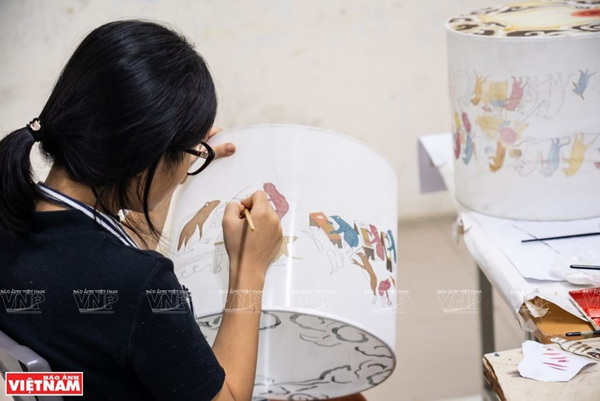 |
| Patterns of Hang Trong paintings are featured on a lantern (Photo: VNP/VNA) |
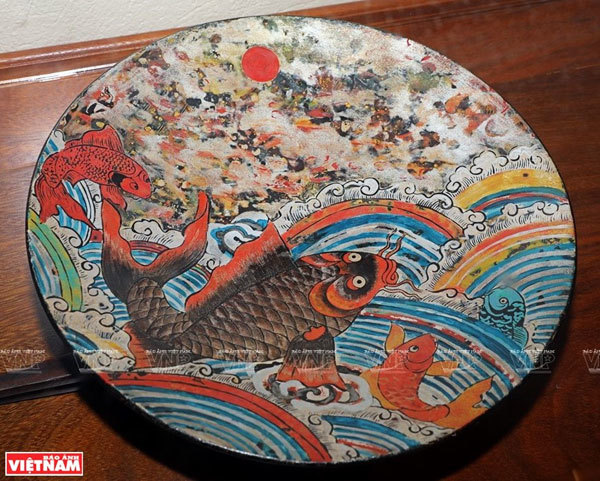 |
| Hang Trong painting is a genre of Vietnamese woodcut painting that originated from the area of Hang Trong and Hang Non streets in the Old Quarter of Hanoi. The genre dates back to about the 16th century and peaked in the late 19th century and early 20th century. In the photo: Some of the art works on show. (Photo: VNP/VNA) |
Hang Trong folk paintings - A a touch of the legacy in the modern life
Hang Trong folk print - a combination of traditional cultural values with ancient artistic methods contributed to the development of folk painting craft, making it flourish once upon a time.
Ever since the 1970s, Hang Trong prints have been on sale all over Hanoi three weeks before Tet. The paintings were once very popular among Vietnamese and had been displayed for sale on the ancient streets of Hang Trong, Hang Non or Hang Quat in Hanoi’s Old Quarter area.
The paintings had set their place deeply in the soul of Hanoian and remained its feature unchangeable in spite of the upheavals of the times.
Hang Trong folk painting uses wood carving technique to print colorful inks on ‘do’ paper. In making a painting, the craftsman starts with woodblocks to print black outlines, then draws the details and finally colours the picture in by hand.
Woodblock making is the most important part of the painting producing process, which must be made by skillful craftsmen. The person who created the first-ever painting on woodblock is usually the best one among craftsmen. His dedicated skillful drawing will decide the beauty of a Hang Trong painting later. It might take months for a craftsman to finish a sophisticated printing sample.
The imprints of the ritual and daily life
Hang Trong paintings have vivid colours that reflect the beauty and rich culture of the community where they are originated. The folk paintings portrayed themes that associated with Vietnamese daily life such as: Tet paintings, worshiping paintings and paintings that depict people daily activities.
The subjects of paintings are also in variety including Tu quy - four specious kinds of trees and flowers of pine, bamboo, chrysanthemum and apricot; Ngu ho - Five Tigers; Ly ngu vong nguyet - Carp Looking at the Moon; To nu - Four female musicians; Chim cong -peacock, Tam Da – three gods symbolising longevity, prosperity and happiness; Cho que – rural market, Mau thuong ngan - Mother Goddess of the Forest; among others.
One of Hang Trong’s best loved images is the Carp Looking at the Moon. The carp symbolized the strong will. According to legend, it refused to accept the fate of ordinary fish and won a contest to cross the Rain Gate, thus becoming a dragon, king of all aquatic creatures.
Another revered image of folk painting is that of the tiger, a sacred image and a symbol of strength. There used to be many tigers in Vietnam, they were believed to be capable of defeating demons. A tiger image of the front door protects a house from evil forces.
The painting of “Little Seven” is originated from the old opinion as “the more children, the greater the parents’ happiness”. For rice growers who need manpower for planting and the harvest, children were literally a source of wealth.
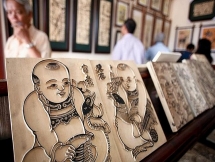 | Dong Ho folk paintings dossier submission to UNESCO reaches agreement Prime Minister Nguyen Xuan Phuc has concurred to submit a dossier of Dong Ho folk paintings to UNESCO, entering the Vietnamese traditional art into the ... |
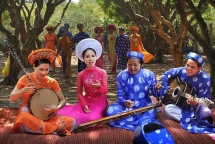 | New art project preserves folk singing of South A project to preserve dien xuong (singing and talking), a folk singing genre which originated in the country’s southern region, will launch this week in ... |
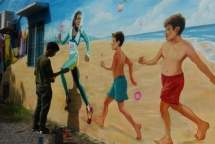 | Australia-Vietnam art project decorates village Old houses in Tân Tịch Hamlet, Cao Lãnh City, in the southern province of Đồng Tháp, are being colourfully decorated as part of the Australia-Vietnam ... |
Recommended
 Handbook
Handbook
Vietnam Moves Up 8 Places In World Happiness Index
 Handbook
Handbook
Travelling Vietnam Through French Artist's Children Book
 Multimedia
Multimedia
Vietnamese Turmeric Fish among Best Asian Dishes: TasteAtlas
 Handbook
Handbook
From Lost to Found: German Tourist Thanks Vietnamese Police for Returning His Bag
 Handbook
Handbook
Prediction and Resolution for the Disasters of Humanity
 Handbook
Handbook
16 French Films To Be Shown For Free During Tet Holiday In Vietnam
 Handbook
Handbook
Unique Cultural and Religious Activities to Welcome Year of the Snake
 Handbook
Handbook

